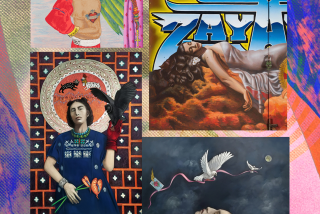SKIRBALL : Virtues of âBlessingsâ Shine Over Problems
To celebrate its first full-scale exhibition of contemporary L.A. art, the Skirball Cultural Center is presenting works by some 50 artists under the title âBlessings and Beginnings.â Without wishing to throw cold water on the festivities, one has to admit that artistically the results are something of a mixed blessing.
The idea comes from an ancient Hebrew thanksgiving benediction in praise of new things. The show was put together by three Skirball curators, director Nancy M. Berman and her colleagues Barbara Gilbert and Monica Billet. Their hearts were clearly in the right place, but even the best intentions can get carried away.
One good impulse at work was the idea of inclusiveness. Although the centerâs principal mission is to âinterpret the Jewish experience, to nurture American Jewish identity and to strengthen American society,â the roster includes artists of quite varied styles and backgrounds. This is clearly a good idea and a generous gesture as long as the various artists are operating on approximate parity in terms of quality. This is not the case here, so the exhibition looks more than a bit uneven.
Another generic bugaboo loose in the proceedings plagues all but the most deft of group exhibitions driven by a set curatorial theme bearing on content. Here the stated topic is celebration. But part of the fun and risk of being an artist is that in making work one is only fractionally in control. An artist may set out to make something upbeat but--double-crossed by the subconscious--wind up with something dark and brooding.
That seems to be the case, for example, with Tony Berlantâs tin-collage composition âBurning Bush.â Like numerous of the invited artists, Berlant made the piece especially for the show. It consists of a motto in Hebrew running down one side next to a vortex-like shape. Actually a blowup of the artistâs thumbprint, it reads like universal chaos. Itâs a very good piece, but its emotional vectors are Expressionist rather than lyrical.
âItâs a Tree of Life to Those Who Hold Fast to Itâ by the lesser-known Joyce Dalall harbors an even more unruly gremlin. Itâs presumptive conscious intent is to tell the story of an immigrant family over four generations. This is done with a silent videotape recounting the saga in words and a few images. The story is quite touching but not nearly as visually persuasive as the tableau surrounding it. The TV monitor is set in a cabinet that looks like an ark. It rests on a prayer rug bearing an image of the tree of life upon which rests a big comfy wing chair facing the TV. The piece becomes less celebratory and more satirical of a culture where religion has been replaced by media.
*
Even if these pieces subverted the artistsâ intentions, they were smart to stick with them. They feel surprising, authentic and slightly naughty in their contradiction of curatorial fiat. Numerous pieces in the show betray signs that their authors forced them to conform to the theme. They come across as workmanlike, heartless and insincere.
As if to prove the power of creative paradox, some of the best and most appropriate works here seem to have purposely caromed off the theme or were made for other purposes altogether.
A wall label says Peter Shireâs âWay L.A.â was inspired by some friends from Boyle Heights who happen to have an irrepressible capacity for happiness. Itâs an installation made of wonderful brightly colored, toylike Bauhaus-style figures suspended from the ceiling. Some have the wings of angels, other those of airplanes, but everybodyâs flying, including a mechanical cyclist on a tightrope. The whole evokes that wonderful age of innocence when kids just feel like that.
John Outterbridgeâs âWe Share the Yamsâ was included in another exhibition recently so it probably wasnât especially designed for this one. Nonetheless it plays as if it were. An installation of a stylized Native American tepee in a ritual circle of yams, it includes an inner circle of watermelon. Itâs a risible, delicious instance of an African American using symbols of racial stereotyping to express empathy with Native Americans.
Other pieces work just fine as well--Michael C. McMillenâs elegiac painting of a wrecked trailer; Jo Anne Callisâ subtly seductive âCurtainâ; George Hermsâ ironic âThe Big Inningâ; and Lita Albuquerqueâs homage to ancient beginnings, âParticle Memory,â are among them.
Kathryn Jacobiâs âLittle Violinistâ is a particularly engaging, well-executed painting about childhoodâs love-hate relationship with tradition.
On reflection the various hiccups, missteps and contradictions of âBlessings and Beginningsâ do not extinguish its essentially positive spirit.
* Skirball Cultural Center, 2701 N. Sepulveda Blvd., through Feb. 2, closed Mondays, (310) 440-4500.
More to Read
The biggest entertainment stories
Get our big stories about Hollywood, film, television, music, arts, culture and more right in your inbox as soon as they publish.
You may occasionally receive promotional content from the Los Angeles Times.










